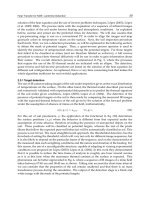Developments in Heat Transfer Part 7 doc
Bạn đang xem bản rút gọn của tài liệu. Xem và tải ngay bản đầy đủ của tài liệu tại đây (1.54 MB, 40 trang )
Developments in Heat Transfer
230
Fig. 2. Schematic diagram of the heat generation in a biological tissue: (a) a photon with the
energy hv is applied in the molecule A, then goes to an excited state A*. (b) The molecule A*
collides with B. (c) A* transfers its energy to B; B becomes
()
cin
B
ε
ε
+
Δ and starts to vibrate
more intensely
Fig. 3. Schematic diagram showing the laser-tissue interaction: reflection, scattering,
absorption and transmission
b. Macroscopic model
In a macroscopic approach it could be observed that the heat generated is directly related
with the laser propagation in the tissue. For that, it is convenient to remember how the heat
Heat Generation and Transfer on
Biological Tissues Due to High-Intensity Laser Irradiation
231
propagation occurs. When a laser beam irradiates a sample (Figure 3), a part of the beam is
reflected and the other part penetrates in the surface. That part which penetrates is
attenuated mainly in two different ways: the absorption and scattering - as long as the beam
penetrated in the sample.
The absorption and the scattering are characterized for absorption coefficient (μ
a
) and
scattering coefficient (μ
s
), which represents, respectively, the rate of radiation energy loss
per penetration length unit, due the absorption and the photons scattering. These two
coefficients are specific to each tissue and depend on the laser wavelength.
Fig. 4. Laser beam attenuation as a function of penetration length
To simplify, initially consider an absorber and not scattering sample. In this case, the beam
attenuation is described by the Beer’s law (Figure 4):
0
()
a
z
Iz I e
μ
−
⋅
=⋅
(5)
where
I is the beam intensity that depends on the penetration length z and I
0
is the intensity
for
z = 0. The inverse of the absorption coefficient is defined as the optical absorption length
(
L) (Figure 4):
1
a
L
μ
=
(6)
The generated heat per area unit and per time unit, in a very small thickness ∆z, is given by:
() ( ) ()
() ()
a
Iz Iz z Iz
Sz Iz
zz
μ
−+Δ ∂
==−=⋅
Δ∂
(7)
The equation 7 expresses that the generated heat in the tissue is equal to the absorbed
energy and can be described as the absorption coefficient multiplied by the local intensity.
Developments in Heat Transfer
232
In the most cases, the light is both absorbed and scattered into the sample simultaneously.
The beam attenuation continues to be described by a similar law from the Beer’s Law, but
now the attenuation coefficient is the sum of the absorption and scattering coefficients,
which is called total attenuation coefficient
()
Tas
μ
μμ
=
+ .
1.5 Heat propagation in biological tissues
The heat conduction equation in a material medium is given by:
2
Tk S
T
tc c
ρ
ρ
∂
=∇+
∂
⋅⋅
(8)
where T is the temperature (°C), t is the time (s), k is the thermal conductivity, ρ is the tissue
density (g/cm
3
), c is the specific heat (cal/g.°C) and S is the generated heat per area and per
time (cal/s.cm
2
).
This equation can be deduced from the diffusion general equation, but it requires a specific
Physics and Mathematical knowledge. Therefore it is important to know that it describes a
strong correlation among the temperature temporal variation
T
t
∂
⎛⎞
⎜⎟
∂
⎝⎠
, the temperature spatial
variation
2
()T∇ and the laser source S. It is also important to say that this same equation
also works when the sample is not being irradiated. In order to calculate how the heat
propagates after an exposure time, when the laser beam is off, it is only necessary to solve
the equation 8 with S = 0
There are some other thermal parameters related to the heat propagation. The thermal
penetration length is a parameter that describes the propagation extension per time, and it is
given by:
() 4
thermal
zt t
α
=
⋅⋅ (9)
where
k
c
α
ρ
=
⋅
is the tissue thermal diffusivity and t is the time. For instance, the thermal
diffusivity of water is
72
1.4 10 ms
α
−
=× .
Other important parameter is the thermal relaxation time, which is obtained mathematically
correlating the optical penetration length with thermal penetration length:
thermal
Lz
=
1
4
thermal
a
ατ
μ
=⋅⋅
2
1
4
thermal
a
τ
μ
α
=
⋅
⋅
(10)
The thermal relaxation time (equation 10) describes the necessary time to the heat
propagates from the surface of irradiation until the optical penetration length and is
particularly important when the intention is to cause a localized thermal damage, with
minimal effect in adjacent structures. This parameter can be interpreted as follows: if the
Heat Generation and Transfer on
Biological Tissues Due to High-Intensity Laser Irradiation
233
time of the laser pulse is smaller than the relaxation time, the heat would not propagate
until a distance given by the optical penetration length
L. So the thermal damage will
happen only in the first layer where the heat is generated. On the other hand, if the time of
the laser pulse is higher than the relaxation time, the heat would propagate for multiple of
the optical penetration length, resulting in a thermal damage in a bigger volume to the
adjacent structures.
2. Characteristics of dental tissues and their influence on heat propagation
The tooth is composed basically for enamel, dentin, pulp and cementum. Enamel, dentin
and cementum are called “dental hard tissues”, and the main constituent is represented by
the hydroxyapatite (Chadwick, 1997; Gwinnett, 1992) (Figure 5). Dentin and cementum have
higher water and organic compound percentage when compared to the enamel and, due to
this composition, they are more susceptible to heat storage than the enamel. Dentin has low
thermal conductivity values and offers more risk when lasers irradiate in deeper regions,
considering that dentinal tubules area and density increase at deepest regions, and
subsequently, can easily propagate the generated heat (Srimaneepong et al., 2002). As an
example, considering the use of CO
2
lasers in dentistry (wavelength of 9.6 µm or 10.6 µm),
the absorption coefficient for dentin tissue is lower than enamel due to its low inorganic
content; also, the thermal diffusivity is approximately three times smaller, which can lead a
less heat dissipation amount and, as a consequence, can induce higher pulp heating (Fried et
al., 1997).
Fig. 5. Representation of a molar tooth, evidencing the macroscopic structures
Developments in Heat Transfer
234
Dental pulp is a connective and vital tissue, and the higher vascularization makes this tissue
strong susceptible to thermal changes. The minimal change in pulp temperature (ΔT ≤ 5 °C)
is sufficient to alter the microvascularization, the cellular activation and their capacity of
hydratation and defense (Nyborg & Brännström, 1968; Zach & Cohen, 1965).
The majority of high intensity lasers used for dental hard tissues cause photothermical and
photomechanical effects. Photons emitted at wavelength of visible and near infrared regions
of electromagnetic spectrum are poorly absorbed by dental hard tissues (Seka et al., 1996)
and, due to this fact, the heat diffusion to the pulp is easy. In this way, in order to choose a
parameter of laser irradiation for a clinical application, it is necessary to establish limit energy
densities that promote a significant temperature increment on enamel and dentin surface, in
order to produce mechanical and/or thermal effects on these structures (Ana et al., 2007).
Also, the temperature increment inside the pulp tissue must be bellowing a temperature
threshold.
Previous studies have indicated that temperature increments above 5.6 °C can be considered
potentially threatening to the vitality of the pulp (Zach & Cohen, 1965) and increments in
excess of 16 °C can result in complete pulpal necrosis (Baldissara et al., 1997). Further studies
showed levels of 60% and 100% of pulp necrosis when pulp tissue was heated about 11 °C
and 17 °C, respectively (Powell et al., 1993). The pulpal temperature rise due to laser-tissue
interaction has also been investigated and most of lasers systems promoted an increase in
pulpal temperature dependent on the power setting (Ana et al., 2007; Yu et al., 1993; Zezell
et al., 1996; Boari et al., 2009).
As well as the knowledge of laser wavelength, energy density and pulse duration, another
point to be considered in heat transfer is the tissue characteristics and the influence of the oral
environment. Although the calculation of heat transmission and dissipation is performed
using hole sound teeth at
in vitro studies, in clinical situations several characteristics of
tissue can change, such as the type of teeth, the remaining thickness, the presence of saliva
and the presence of demineralization (Ana et al., 2007; Powell et al., 1993). For instance, due
to the great amount of water in carious lesions, the heat transfer to the pulp can be more
excessive in decayed teeth. Relating the influence of tissue thickness, White
et al.(1994)
determined that Nd:YAG laser irradiation with a power output of 0.7 W (approximately 87
J/cm
2
) induces an increase of 43.2 °C in a remaining dentin thickness of 0.2 mm and induces
an increment of 5.8 °C in a dentin thickness of 2.0 mm. Considering that the human teeth
present a big variation in volume and weight, and taking into account the low thermal
conductivity of dentin, the operator must judge the physical conditions of dental hard tissue
in order to adequate the exposition time to avoid dangerous thermal effect on pulp.
3. Changes in tissue thermal characteristics during laser irradiation
Considering the laser irradiation in dental hard tissues, it is necessary to know and to
understand the thermal behavior of these tissues when submitted to heating. For that, the
evaluation of the heat conduction phenomenon is extremely necessary.
Teeth are mainly composed by hydroxyapatite that, in principle, has high heat capacity
value and low heat conduction value (Pereira et al., 2008). The main reason of the changes of
thermal parameters of hydroxyapatite can be explained by the complexity of the photon
diffusion into the material due to the ionic bond between the chemical elements.
Several studies about thermal parameters measurement in hard dental tissues have been
published (Brown et al, 1970; Incropera et al., 2006). Results of these studies are summarized
in table 1.
Heat Generation and Transfer on
Biological Tissues Due to High-Intensity Laser Irradiation
235
Thermal parameter Enamel Dentin Water
Specific Heat (J/g°C)
0.71
(Brown et al, 1970)
1.59
(Brown et al, 1970)
4.18
(Incropera et al., 2006)
Thermal conductivity
(10
-3
W/cm °C)
9.34
(Brown et al, 1970)
5.69
(Brown et al, 1970)
6.1
(Incropera et al., 2006)
Thermal diffusivity
(10
-3
cm
2
/s)
4.69
(Brown et al, 1970)
1.86
(Brown et al, 1970)
1.3
(Incropera et al., 2006)
Table 1. Thermal parameters of dental hard tissues (enamel and dentin) and water
Although these thermal values are well-established in literature and can be used for
supporting clinical applications, it is important to consider that all parameters were
measured at room temperatures. In the moment of laser irradiation of dental hard tissues,
the temperature increase can lead several chemical and ultra-structural changes on enamel
and dentin (Bachmann et al., 2009; Fowler & Kuroda, 1986); as a consequence, the tissue
thermal characteristics of tissue may change during laser irradiation.
Several studies have been developed in order to propose theoretical models of heat
propagation in dental hard tissues (Craig R.G & Peyton, 1961; Braden et al., 1964). These
models assumed that thermal parameters are constant in function of temperature, which
seems to be not true according to the discussed above. Thus, we have to assume that the
determination of laser irradiation parameters based only by theoretical calculation that
consider thermal properties as constant can be wrong. Figure 6 shows experimental data
(Pereira et al., 2008), obtained by infrared thermography, of the thermal diffusivity changes
as function of temperature changes.
Fig. 6. Thermal diffusivity of dentin as function of temperature (Pereira et al., 2008)
Developments in Heat Transfer
236
Figure 7 shows the changes on heat penetration on dentin in function of time of exposure. It
can be seen that data obtained vary among the related studies due to the fact that some of
them consider the thermal diffusivity values always constant, while the present study
(Pereira et al., 2008) consider the changes in thermal diffusivity according to the temperature
(Figure 7). This fact has significant relevance mainly for clinical procedures using laser
irradiation, when it is necessary temperature increases up to 800 °C for cutting dental hard
tissues and for caries prevention, for example (Fried et al., 1996; Ana et al., 2007). When a
tooth is submitted to this temperature elevation, the heat spreads more quickly than
calculated by theoretical models that considered thermal diffusivity values as constant,
which can represent a problem mainly for the deeper tissues (pulp tissue).
0 2 4 6 8 10
0,00
0,05
0,10
0,15
0,20
0,25
0,30
time (s)
Craig
Braden
pereira300
pereira500
thermal depth (cm)
Fig. 7. Calculated thermal depth (cm) in function of time (t) for dentin tissue, obtained by
four different literature studies (Pereira et al., 2008)
4. Considering temperature to determine clinical protocols using lasers
As it was stated previously, for the determination of clinical protocols it is demanding to
consider the safety and efficacy of lasers, also the characteristics and properties of target
tissues. Besides that, literature studies clearly show that laser features, such as wavelength,
mode of operation (continuous
versus pulsed modes), temporal pulse length and repetition
rate are characteristics directly related with pulp heating. In this way, among the optical
properties, the transmission is the most important property to be considered for preserving
pulp vitality.
Among high intensity lasers with high absorption and low transmission through enamel
and dentin, erbium lasers seems to be the most appropriated wavelength to be used in
dentistry. However, some studies point out that, even with this laser, the repetition rate and
pulse duration are decisive on determining clinical parameters; for example, the longer
pulse duration is, the higher is the heat generated in pulp (Yu et al., 1993).
Taking into account the clinical application of high intensity lasers on dental hard tissues,
some strategies may be useful to control the heat generation and transmission on these
Heat Generation and Transfer on
Biological Tissues Due to High-Intensity Laser Irradiation
237
tissues. In order to restrict the heat dissipation through the teeth tissues, the application of a
photosensitizer is frequently applied over the enamel and dentin surfaces before laser
irradiation, and this application can avoid pulpal damages even when laser irradiation
occurs with high energy densities (Tagomori & Morioka, 1989; Jennett et al., 1994). The
application of a photosensitizer before laser irradiation is commonly used in order to
enhance surface tissue absorption in the near-infrared range for ablation and caries
prevention actions in dental tissues, considering that some lasers, such as Nd:YAG and
Ho:YAG, are poorly absorbed by enamel and dentin. The absorption of the laser beam is
increased at the surface of the enamel and the heat produced due to laser absorption in the
coating material is transmitted into the adjacent enamel. This technique certifies the deposit
of a short laser pulse energy to a small volume of tissue, avoiding the excessive laser beam
penetration in deeper dental structures and consequently with less risk of damages in dental
pulp (Boari et al., 2009).
The use of Indian Ink is a well-recognized and efficient technique to reduce beam
transmission on dental hard tissues. However, because of the difficulty in its removal, which
can prejudice the aesthetics of remaining teeth, it has been suggested the application of a
coal paste, a mixture of triturated vegetal coal in 50% ethanol, which is biocompatible, easy
to remove and presented important results in previous
in vitro (Boari et al., 2009) and in vivo
(Zezell et al., 2009) studies. In an
in vitro study performed by our group, it was
demonstrated that the enamel recovering with the coal paste promoted an increase of
surface temperatures, which confirmed the absorption of laser beam at the surface (Ana et
al., 2007) (Figure 8). Also, the coal paste significantly decreased the heat transfer into the
teeth when enamel was irradiated with Nd:YAG and Er,Cr:YSGG lasers, and can assure the
pulpal safety when laser irradiation is performed for a long period of time. The
Fig. 8. Surface temperature increase on enamel surface during Er,Cr:YSGG (λ = 2078 nm)
laser irradiation with and without the application of coal paste (Ana et al., 2007). It can be
noted that, even at three different average powers, the presence of the photosensitizer
significantly increased the surface temperature during laser irradiation. Bars mean standard
deviation
Developments in Heat Transfer
238
morphological changes promoted on enamel surface are similar than those promoted by the
recovering with Indian Ink, showing evidences of surface heating that promoted melting
and recrystallization of enamel (Boari et al., 2009) (Figure 9).
(a)
(b) (c)
Fig. 9. Scanning electron micrography of dental enamel after irradiation with Nd:YAG
(λ = 1064 nm) laser irradiation at energy density of 84.9 J/cm
2
after surface recovering with
Indian Ink (a) or coal paste (b) or no recovering (c) (Boari et al., 2009). It is possible to note
the presence of melting and recrystallization of enamel after recovering with coal paste and
Indian Ink. These characteristics are not observed when enamel is irradiated without the
presence of a photosensitizer. Original magnification = 3500 X. (a) enamel + Indian Ink;
(b) enamel + coal paste; (c) sound enamel
The presence of air-water spray during laser irradiation is another strategy used for
clinicians to avoid excessive heat generation on the pulp. The water coolant allows the
cleaning of surfaces to be irradiated and increases the efficacy of ablation phenomenon, in a
process called “water augmentation” (Fried et al., 2002). When dental hard tissues are
irradiated with Er:YAG in addiction to a thin water layer, studies relate that the cutting
efficiency increases at the same time that the pulp temperature decreases. However, the
thickness of water layer should be well-controlled, considering that erbium lasers interacts
primary with water and an thick water layer over the tissue can restrict the laser interaction
with the enamel bellow it and, as a consequence, the absorption by the target tissue can
decrease.
Heat Generation and Transfer on
Biological Tissues Due to High-Intensity Laser Irradiation
239
5. How to determine temperature variations in biological tissues?
Among physical methods to determine the temperatures on materials, the thermocouples
(Ana et al., 2007; Boari et al., 2009), elliptical mirrors, HgCdZnTe detectors (Fried et al., 1996)
and infrared cameras (Ana et al., 2007) are the most used ones to measure temperature
changes in pulp, periodontal tissues and dental hard tissues surfaces. These techniques
present good accuracy and efficacy, and can be easily adapted to experimental conditions.
However, it should be considered that all experimental methods present some difficulties,
such as sample standardization (considering the large variation in volume, size, thickness,
and hydratation degree of tissues), the exact duplication of the thermal load, accuracy,
availability and cost of equipments (Ana et al., 2008).
The finite element method model (FEM model) is another method that has been popular
among researchers, taking into account that this technique is a good analytical tool to model
and simulate the thermal or mechanical behavior of dental structures (Toparli et al., 2003).
The FEM model can be used to simulate the effects of laser on enamel and dentin, but not on
gums or inside the pulp cavity, which is filled with blood vessels and innervated tissues,
since these materials are soft and highly inhomogeneous. However, the effects of laser
irradiation could be difficult to simulate even on the dental hard tissues (only enamel and
dentine), since the thermal characteristics of these materials may not have been well
determined.
It must be pointed out that all the
in vitro methods do not reproduce exactly all the
interferences of the oral environment in the photothermal response of enamel and dentin
tissues, such as the influence of surrounding saliva, pulpal and periodontal tissues, presence
of biofilm, body temperature and other factors (Ana et al., 2008).
Fig. 10. FEM model used to simulate the heat generation and transmission at dental pulp
during Er,Cr:YSGG laser irradiation (Ana et al., 2008)
Developments in Heat Transfer
240
Fig. 11. Calculated temperature distribution: The gray scale represents the temperature in
Celsius. The sequence of images illustrates the effects of irradiation with a laser beam and
the propagation of heat through the tooth after the beam is turned off
6. Pre-clinical studies
As affirmed previously, the pre-clinical studies are necessary to predict the biological effects
of high-intensity lasers and to establish possible parameters and conditions for a future
application in dental practice. For preventing dental caries, for example, infrared lasers such
as Nd:YAG and Er,Cr:YSGG can be indicated.
The Er,Cr:YSGG laser is emitted in 2.78 µm wavelength, which is better absorbed by water
and OH
¯
contents of hydroxyapatite (Seka et al., 1996), and promotes surface temperatures
up to 800 °C at the ablation threshold (Fried et al., 1996). Due to this fact, Er,Cr:YSGG laser is
applied for cutting of enamel, dentin and root surfaces, and also for caries prevention.
In a first
in vitro study, surface temperature measurements were performed in order to
verify if this laser had potential to promote chemical and crystalline changes on dental
enamel, which can occur in temperatures above 100 °C (Bachmann et al., 2009). For that, the
temperature changes in enamel surface during and immediately after laser irradiation were
monitored using an infrared high resolution fast thermographic camera (ThermaCam FLIR
SC 3000 Systems, USA), which stores infrared images and data at rates up to 900 Hz. This
experiment was performed at a controlled room temperature of 24.6 °C, 47 % air relative
humidity and considering teeth emissivity as 0.91. The thermographic camera was
positioned at 0.1 m distance of samples and the obtained infrared images were recorded at
rates of 900 Hz for later analysis (Ana et al, 2007).
For laser irradiation, laser handpiece was positioned at focused beam, at 1 mm distance
from the enamel surface. This assembly was kept in optical supports and the area of interest
was isolated at a focal length of 0.1 m using an internal macro lens.
The results of surface temperature obtained in this study (Ana et al., 2007) are shown in
Figure 12. It is possible to evidence that the surface temperature rises with the increase of
energy density, and the presence of photosensitizer (coal paste) propitiated higher
temperature values when compared to the surfaces in which were not previously recovered
Heat Generation and Transfer on
Biological Tissues Due to High-Intensity Laser Irradiation
241
with the coal paste. In this way, even using laser wavelengths highly absorbed by dental
enamel, the application of a photosensitizer in the enamel surface can potentiate the
absorption phenomenon. This can reflect on temperature rise and, in this way, crystalline
changes at this superficial enamel may occur and can favor the caries preventive effect.
Another point to be considered is that the temperature rise of 247.6 °C found when teeth
were irradiated with 8.5 J/cm
2
is lower than that temperature reported by literature studies,
who found approximately 400 °C measured by an elliptical mirror and a HgCdZnTe
detector with a time resolution of 1 µs (Fried et al., 2006). In this way, the temperature
elevation during Er,Cr:YSGG laser irradiation could be higher than those detected by
infrared camera. Taking into account that the pulse width of Er,Cr:YSGG laser is 140 μs,
even the 900 Hz recording rate of the infrared thermographic method seems to be unable to
detect the highest temperature peaks during laser irradiation. In this way, the infrared
thermographic camera gives an idea of average temperature changes when teeth are
irradiated with high intensity lasers. However more accurate systems are required to
precisely determine the maximum temperature peaks, such as the use of integrating sphere.
-2 0 2 4 6 8 1012141618202224
20
40
60
80
100
120
140
160
180
200
220
240
Temperature (
o
C)
Time (s)
2.8 J/cm
2
without coal
5.6 J/cm
2
without coal
8.5 J/cm
2
without coal
2.8 J/cm
2
with coal
5.6 J/cm
2
with coal
8.5 J/cm
2
with coal
Fig. 12. Dental enamel surface temperature measurement, by infrared thermography,
during Er,Cr:YSGG laser irradiation at parameters aimed at caries prevention (Ana et al.,
2007)
For measurement of heat transfer to the pulp chamber, the use of fast-response
thermocouples seems to be more accurate since it is not possible to see the heat transfer from
enamel to pulp by infrared thermography, unless the teeth are half-sectioned.
In this way, calibrated K-type chromel-alumel thermocouples (Omega Engineering,
Stanford, USA) were inserted inside the pulp chamber of sound molar human teeth, which
Developments in Heat Transfer
242
were previously filled with a thermally-conductive paste (thermal conductivity of 0.4 cal s
-1
m
-1
K
-1
– Implastec, Votorantim, Brazil) in order to keep thermal contact between the probe
end and dentin surface. These thermocouples had 0.05 mm diameter probe and were
sensitive to temperature variations between 0.1 °C and 100 °C. The temperature sensitive
end of the probe was placed at the closest distance to the area to be irradiated, and its
location was controlled radiographically for each sample (Romano et al., 2011). The
thermocouple apparatus was connected to an analogue-to-digital converter (SR lock-in
amplifier, Stanford Research System, USA) linked to a computer, and time and temperature
data were recorded at sampling rate of 20 Hz, with temperature resolution of 0.1
o
C. During
laser irradiation, samples were fixed and immersed in a water-filled heating circulator at
standardized temperature of 37 °C, with only the coronal part of the tooth not being
submerged in order to simulate body temperature in the oral environment.
0 102030405060
0.0
0.5
1.0
1.5
2.0
2.5
3.0
3.5
4.0
4.5
5.0
Δ T (
o
C)
t (s)
2.8 J/cm
2
w ithout coal
5.6 J/cm
2
w ithout coal
8.5 J/cm
2
w ithout coal
2.8 J/cm
2
w ith coal
5.6 J/cm
2
w ith coal
8.5 J/cm
2
w ith coal
Fig. 13. Pulp chamber temperature variation during enamel surface irradiation with
Er,Cr:YSGG laser, measured by fast-response thermocouples (Ana et al., 2007)
Figure 13 shows the results of temperature evaluation inside the pulp chamber during
enamel irradiation by Er,Cr:YSGG laser. It is possible to observe that the device can detect
minimal temperature variations and, although surface temperatures detected increased up
to 230 °C, the pulp temperature variations were up to 4.5 °C. This fact evidences that dental
enamel and dentin are good thermal insulating tissues. Also, the presence of the
photosensitizer on enamel surface was important to effectively reduce the heat transfer
through the pulp chamber, increasing the safety of a future clinical procedure. It must to be
emphasized that the time of exposure is important and further histological
in vivo studies
are also necessary to confirm this hypothesis.
Heat Generation and Transfer on
Biological Tissues Due to High-Intensity Laser Irradiation
243
All studies described previously were performed to evaluate just one possible clinical
application of Er,Cr:YSGG laser. Considering that this laser can be used for multiple
applications, the development of a FEM model could be a faster tool to evaluate the heat
generation and transfer to dental hard tissues. In this way, a further study was performed to
develop this model and to compare the simulation results with those obtained
experimentally (Ana et al., 2008).
For that, a geometric FEM model of a half-sectioned double rooted molar tooth was
constructed using a typical profile of a tooth root. Since the goal was to calculate the
temperature distribution on the surface and inside the tooth, in each element of the model
the total heat is given by the internal heat, determined by the material density (
ρ) and
specific heat (
c), and the heat flux, determined by the element material thermal conductivity
(α). In this study, the external heat source is due to almost instantaneous light absorption
converted into heat. Moreover, in spite of not considering wavelength dependence with
absorption, reflection, transmission and scattering, the FEM model predicts accurate values
for temperatures inside the teeth, mainly because 2.78 µm is strongly absorbed by the dental
hard tissue. The optical penetration is very small (to the order of few micrometers) since the
optical absorption coefficient of enamel is about 7000 cm
-1
.
The
in vitro experiment aimed to compare the results of FEM simulation was performed
using half-sectioned teeth, irradiated with Er,Cr:YSGG laser on enamel surface and
monitored by infrared imaging. This set-up allowed the visual evaluation of temperature
changes and heat diffusion from enamel into dentin and the pulp chamber. Taking into
account that the variation in temperature is also dependent on the volume and weight of a
tooth, the use of sectioned teeth does not correspond to an
in vivo condition inside the
mouth, but gives a reasonable idea of heat transfer inside the tooth and gives the exact value
of surface temperature during laser irradiation. Moreover, in a clinical protocol, laser
irradiation is performed by scanning all over the enamel surface, and it was not possible to
reproduce this situation in the present study. However, in a clinical application of lasers, the
time of irradiation in just one region of tissue is always less than the time considered during
experiments, which increases the safety of evaluated parameters.
Infrared thermographic
camera
Finite element method
model
Energy
Density
Presence of
photosensitizer
Surface Pulp Surface Pulp
yes 79.6
°C 0.5
°C 94.2 °C 0.95 °C
2.8 J/cm
2
no 42.7
°C 1.0
°C 66.0
°C 0.9
°C
yes 184.1
°C 1.5 °C 178.0
°C 1.9 °C
5.6 J/cm
2
no 136.1
°C 1.2 °C 136.0 °C 1.4
°C
yes 247.6
°C 2.1 °C 231.0
°C 2.1
°C
8.5 J/cm
2
no 211.8
°C 1.9 °C 188.0
°C 2.3 °C
Table 2. Comparison of means of temperature rise on surface and in pulp obtained by FEM
model and by thermographic camera (Ana et al., 2008)
Table 2 shows the results of temperature monitoring by infrared thermography and the
simulation by FEM model. It is possible to observe a good correlation between the
in vitro
and computational method, indicating that FEM model can be used as an alternative to
determine heat generation on the enamel surface as well as inside the pulp chamber
Developments in Heat Transfer
244
according to the several laser energies and the presence or not of a photosensitizer.
Although it is not possible to simulate the influence of oral environment on FEM model,
under the given conditions the simulated model was shown to have a good approximation
to the physical reality.
7. Conclusion
The effect of high intensity lasers irradiation on biological tissues and consequently their
clinical uses are based on heat generation, which is necessary to assure effective clinical
procedures such as faster cutting, good homeostasis and desired chemical changes on target
tissues. The comprehension of heating generation and transmission through these tissues is
essential to determine safe irradiation parameters of lasers and, for that, the knowledge of
optical and thermal properties of tissues and their changes due to heat are strongly
necessary. Also, the interaction of laser wavelength with the tissues is necessary to avoid
deleterious effects in target tissues, as well in surrounding ones.
The pre-clinical experiments give us important information about laser-tissue interaction,
and help to suggest laser parameters and conditions for development of a further clinical
protocol. For that, methods such as thermocouples, infrared thermography and finite
element simulation are good tools that demonstrated to be useful on predicting the clinical
results.
8. References
Ana PA, Bachmann L, Zezell DM. Laser effects on enamel for caries prevention. Laser Phys
2006; 16(5): 865 – 875.
Ana PA, Blay A, Miyakawa W, Zezell DM. Thermal analysis of teeth irradiated with
Er,C:YSGG laser at low fluences
. Laser Phys Lett 2007; 4: 827 - 830.
Ana PA, Velloso WF Jr, Zezell DM. Three-dimensional finite element thermal analysis of
dental tissues irradiated with Er,Cr:YSGG laser.
Rev Sci Instrum. 2008; 79(9): 093910.
Bachmann L, Rosa K, Ana PA, Zezell DM, Craievich AF, Kellermann G. Crystalline
structure of human enamel irradiated with Er,Cr:YSGG laser.
Laser Phys Lett 2009;
6: 159-162.
Baldissara P, Catapano S, Scotti R. Clinical and histological evaluation of thermal injuty
thresholds in human teeth: a preliminary study
. J Oral Rehabilitation 1997; 24: 791-
801.
Boari HGD, Ana PA, Eduardo CP, Powell GL, Zezell DM. Absorption and thermal study of
dental enamel when irradiated with Nd:YAG laser with the aim of caries
prevention.
Laser Phys 2009; 19(7): 1463-1469.
Braden M. heat conduction in teeth + effect of lining material
. J Dent Res 1964, 43 (3): 315.
Brown WS, Dewey WA, Jacobs HR. Thermal properties of teeth.
J Dent Res 1970; 49(4): 752-
755.
Chadwick DJ, Cardew G. Dental Enamel. London UK: Chichester-Wiley 1997.
Craig R.G, peyton F.A. Thermal conductivity of Tooth Structure, Dental cements, and
amalgam.
J Dent Res 1961, 40 (3): 411.
Heat Generation and Transfer on
Biological Tissues Due to High-Intensity Laser Irradiation
245
Fowler BO, Kuroda S. Changes in heated and in laser-irradiated human tooth enamel and
their probable effects on solubility.
Calcif Tissue Int 1986; 38: 197-208.
Fried D, Feathestone JDB, Visuri SR, Seka WW. Walsh JT The caries inhibition potential of
Er:YAG and ErCr:YSGG laser irradiation. In: Wigdor HA, Featherstone JDB,
White JM, Neev J
. Lasers in Dentistry II Bellinghan WA Proc SPIE 1996; 2672: 73-
77.
Fried D, Zuerlein MJ, Featherstone JDB, Machule D. Thermal and chemical modification of
dentin by pulsed CO2 laser irradiation at 9-11 µm. In: Wigdor HA, Featherstone
JDB, Rechmann P.
Lasers in Dentistry III Bellinghan WA: Proc SPIE 1997; 2973: 94-
100.
Fried D, Ashouri N, Breunig T, Shori R. Mechanism of water augmentation during IR laser
ablation of dental enamel.
Lasers Surg Med 2002; 31: 186 – 193.
Gwinnett AJ. Structure and composition of enamel.
Oper Dent 1992; Supl 5: 10-17.
Incropera F P., DeWitt D P, Bergman T L, Lavine A S. Fundamentals of Heat and Mass
Transfer. 6th ed., New York: Wiley, 2006.
Jennett E, MotameIi M, Rastegar S, Frederickson C, Arcoria C, Powers JM. Dye-enhanced
ablation of enamel by pulsed lasers.
J Dent Res 1994; 73: 1841-1847.
Nammour S, Kowalyk K, Valici C, Zeinoun T, Rocca JP, Powell GL, Van Reck J. Safety
parameters for pulp temperature during selective ablation of caries by KTP laser in
vitro
. J Clin Laser Med Surg 2004; 22(2): 99-104.
Niemz MH. Laser-tissue interactions: fundamentals and applications. 3rd ed., Berlin:
Springer, 1997.
Nyborg H, Brännström M. Pulp reaction to heat
. J Prosthet Dent 1968; 19: 605 – 612.
Pereira T. M.; Miyakawa, W; Goulart VP; Zezell, DM. In-plane thermal diffusivity of dentin
by infrared thermography. In:
VII Congresso da SBPMAT, 2008.
Powell GL, Morton TH, Whisenant BK. Argon laser oral safety parameters for teeth.
Lasers
Surg Med
. 1993; 13(5):548-52.
Romano AC, Aranha AC, Silveira BL, Baldochi SL, Eduardo CP. Evaluation of carbon
dioxide laser irradiation associated with calcium hydroxide in the treatment of
dentinal hypersensitivity. A preliminary study
. Lasers Med Sci. 2011; 26(1): 35-
42.
Seka W, Featherstone JDB, Fried D, Visuri SR, Walsh JT. Laser ablation of dental hard tissue:
from explosive ablation to plasma-mediated ablation. In: Wigdor HA, Featherstone
JDB, White JM, Neev J.
Lasers in Dentistry II Bellinghan WA. SPIE 1996; 2672: 144-
158.
Srimaneepong V, Palamara JEA, Wilson PR. Pulpal space pressure and temperatura changes
from ND:YAG laser irradiation of dentin.
J Dent 2002; 30: 291-296.
Tagomori S, Morioka T. Combined effects of laser and fluoride on acid resistance of human
dental enamel.
Caries Res 1989; 54: 15-17.
Toparli M, Sasaki S. Finite element analysis of the temperature and thermal stress in a
postrestored tooth
. J Oral Rehabil. 2003; 30(9): 921-6.
White JM, Mark CF, Goodis HE. Intrapulpal temperature during pulsed Nd:YAG laser
treatment on dentin in vitro
. J Periodontol 1994; 65: 255-259.
Developments in Heat Transfer
246
Yu D, Powell GL, Higuchi WI, Fox JL. Comparison of three lasers on dental pulp chamber
temperature change.
J Clin Laser Med Surg 1993; 11(3): 119-122.
Zach L, Cohen G. Pulp response to externally applied heat.
Oral Surg 1965; 19: 515-530.
Zezell DM, Cecchini SCM, Pinotti M, Eduardo CP. Temperature changes under Ho:YLF
irradiation. In: Wigdor H, Featherstone JDB, White JM, Neev J.
Lasers in Dentistry II
Bellinghan WA: Proc SPIE 1996; 2672: 34-39.
Zezell DM, Boari HG, Ana PA, Eduardo CP, Powell GL. Nd:YAG laser in caries prevention:
a clinical trial.
Lasers Surg Med. 2009; 41(1): 31-5.
14
Entransy Dissipation Theory
and Its Application in Heat Transfer
Mingtian Xu
Shandong University
P. R. China
1. Introduction
In this chapter, our recent work on the entransy dissipation theory and its application in
heat convection and the heat exchanger design is reviewed. In that work, the
thermodynamic basis of the entransy dissipation theory is established. It is shown that the
entransy is a state variable and the second law of thermodynamics can be described by the
entransy and entransy dissipation. Then this entransy dissipation theory is applied to the
convective heat transfer and heat exchanger design. The local expression of the entransy
dissipation rate is obtained. The extremum principle of entransy dissipation rate is
proposed. The expressions of the entransy dissipation caused by heat conduction and fluid
friction in heat exchanger are derived. The optimization design of heat exchanger is
discussed.
1.1 The second law of thermodynamics in terms of entransy
The second law of thermodynamics is one of the most important fundamental laws in
physics, which originates from the study of the efficiency of heat engine and places
constraints upon the direction of heat transfer and the attainable efficiencies of heat engines
(Kondepudi & Prigogine, 1998). The concept of entropy introduced by Clausius for
mathematically describing the second law of thermodynamics has stretched this law across
almost every discipline of science. However, in the framework of the classical
thermodynamics the definition of entropy is abstract and ambiguous, which was noted even
by Clausius (Clausius, 1865). This has induced some controversies for statements related to
the entropy. Recently, Bertola and Cafaro found that the principle of minimum entropy
production is not compatible with continuum mechanics (Bertola & Cafaro, 2008). Herwig
showed that the assessment criterion for heat transfer enhancement based on the heat
transfer theory contradicts the ones based on the second law of thermodynamics (Herwig,
2010). The entropy generation number defined by Bejan (Bejan, 1988) is not consistent with
the exchanger effectiveness which describes the heat exchanger performance (Guo et al.,
2009b). Shah and Skiepko (2004) found that the heat exchanger effectiveness can be
maximum, minimum or in between when the entropy generation achieves its minimum
value for eighteen kinds of heat exchangers, which does not totally conform to the fact that
the reduction of entropy generation leads to the improvement of the heat exchanger
performance. These findings signal that the concepts of entropy and entropy generation
may not be perfect for describing the second law of thermodynamics.
Developments in Heat Transfer
248
Although there has been effort to modify the expression of the second law of
thermodynamics (Bizarro, 2008; Ben-Amotz & Honig, 2003, 2006) and to improve the
classical thermodynamics by considering the Carnot construction cycling in a finite time
(den Broek, 2005; Esposito & Lindenberg, 2009; Esposito et al., 2010), the eminent position of
entropy in thermodynamics has not been questioned. Recently, Guo et al. (2007) defined two
new physical quantities called entransy and entransy dissipation for describing the heat
transfer ability and irreversibility of heat conduction, respectively. Guo et al. (2009a) have
introduced a dimensionless method for the entransy dissipation and defined an entransy
dissipation number which can serve as the heat exchanger performance evaluation
criterion. Based on the concept of entransy dissipation, an equivalent thermal resistance of
heat exchanger was defined which is consistent with the exchanger effectiveness (Guo et
al., 2010). Cheng and Liang (2011) defined the entransy flux and entransy function for the
thermal radiation in enclosures with opaque surfaces, and the minimum principle of
radiative entransy loss was established. Chen et al. (2011) proposed an entransy
dissipation rate minimization approach for the disc cooling system and the influence of
various system parameters on the entransy dissipation rate of the cooling system has been
investigated.
Although the concepts of entransy and entransy dissipation have been applied to heat
transfer and demonstrate some advantages in comparison with the entropy and entropy
generation, how to define these concepts from the thermodynamic point of view is still an
open question. In this section we place the concepts of entransy and entransy dissipation on
the solid thermodynamic basis.
1.2 Carnot’s theorem in terms of entransy
We start with the Carnot cycle. In this cycle, the heat engine absorbs heat
1
Q
from the hot
reservoir with the temperature
1
T (absolute temperature is always assumed in the following
discussion), converts part of heat to work W and discards the rest of the heat to the cold
reservoir with the temperature
2
T
. For this cycle, Carnot’s theorem states that (Kondepudi
& Prigogine, 1998)
11 22
//QTQT≤
(1)
where the equality and inequality correspond to the reversible and irreversible heat engines,
respectively. The efficiency of a reversible engine is defined as
2
1
1
T
T
η
=− (2)
Carnot’s theorem dictates that reversible engines have the maximum efficiency (Kondepudi
& Prigogine, 1998).
Equivalently, Inequality (1) can be rewritten as follows
11 2 1 21
()( )QT T Q QT
−
≥− (3)
Inspired by Inequality (3), we define
11 2
()EQT T=−
as the entransy gained by the heat
engine from the hot reservoir in the Carnot cycle. From this definition, one can see that the
larger the amount of heat
1
Q and the temperature difference between the hot and cold
Entransy Dissipation Theory and Its Application in Heat Transfer
249
reservoir, the greater the entransy obtained by the heat engine in the Carnot cycle.
Obviously, the larger entransy means higher ability for heat engine to perform work. Guo et
al. (2007) shown that the entransy can describe the heat conduction ability. Therefore, we
may say that the entransy defined here quantifies the energy transfer ability including the
ability to deliver work and transfer heat.
To obtain the efficiency of a reversible heat engine, firstly we know that
12
WQ Q=−
, which
is the statement of the law of conservation of energy. We define
121 1
()
W
EQQTWT
=
−= and
regard it as the entransy consumed by the heat engine for delivering work W to the
system’s exterior. For the reversible heat engine, Inequality (3) reduces to:
11 2 1 21 1
()( )QT T Q QT WT
−
=− = (4)
which says that the entransy gained by the reversible heat engine in the Carnot’s cycle is
completely converted to work W. While for the irreversible heat engine, Inequality (3) becomes
11 2 1 21
()( )QT T Q QT
−
>− (5)
which tells us that only part of the entransy obtained by the heat engine in the Carnot’s cycle
is utilized to deliver work W, the rest is consumed by the irreversibility in the heat engine.
In order to quantify the irreversibility occurring in the heat engine, we define the entransy
generation in parallel with the entropy generation in the following way:
121112
()()
g
EQQTQTT
=
−−− (6)
While
diss
g
EE=− is called the entransy dissipation which represents the entransy consumed
by the irreversibility in heat engine. Since the reversible heat engine converts the total
entransy gained during the Carnot cycle to perform work, we may define the efficiency of
the heat engine in terms of entransy as follows
1
11 2
()
W
E
E
WT
QT T E
η
==
−
(7)
Notice that the reversible heat engine achieves the maximum value of
E
η
which is equal to
100%. This is the statement of Carnot’s theorem in terms of entransy.
1.3 The second law of thermodynamics
Carnot’s theorem has played a pivotal role on the development of the classical
thermodynamics. By generalizing Inequality (1) to an arbitrary cycle, Clausius introduced
the concept of entropy which is a physical quantity as fundamental and universal as energy.
In this section, we aim to generalize Inequality (3) to an arbitrary cycle. Firstly, Inequality (3)
can be rewritten as follows:
11
0QTTQ
Δ
+Δ≥
(8)
where
12
TT TΔ= − ,
12
()QQQ
Δ
=− − . Note that since the system delivers energy to its
exterior, therefore
0Q
Δ
< .
An arbitrary cycle can be decomposed into a group of Carnot’s cycles denoted as
(1,2, )
i
Ci n= " (Kondepudi & Prigogine, 1998). Applying Inequality (8) to the i-th Carnot’s
cycle yields:
Developments in Heat Transfer
250
,,
0
ai i i hi
QT QT
Δ
+Δ ≥ (9)
where
,ai
Q is the heat absorbed from the hot reservoir with the temperature
,hi
T ,
,,
()
iairi
QQQΔ=− − (
,ri
Q is the heat discarded into the cold reservoir),
,,ihici
TT T
Δ
=− (
,ci
T
is the temperature of the cold reservoir). If the number of Carnot’s cycles under
consideration tends to the infinity, the temperature difference between the hot and cold
reservoirs approaches to infinitesimal, Inequality (9) becomes
0QdT T Q
δ
+
≥
∫
v
(10)
For a reversible cycle, there is no heat conduction, Inequality (10) reduces to
0QdT T Q
δ
+
=
∫
v
Equation (11) suggests that we can define a quantity E called the entransy as follows
dE QdT T Q
δ
=
+ (11)
which only depends on the initial and final states of a reversible process. Thus the entransy
is a state variable. If
A
E
and
B
E
are values of this variable in the initial state A and final
state
B, respectively, we have
B
BA
A
EE QdTTQ
δ
−= +
∫
(12)
If the temperature remains fixed, it follows from Eq. (12) that for a reversible flow of heat
Q
δ
, the change in entransy is TQ
δ
, while the change in entropy is /QT
δ
. For this case we
get the following relationship between the entransy and entropy,
2
dE T dS=
(13)
Consider an irreversible process
I which starts from the equilibrium state A and ends at the
equilibrium state
B. In order to form a cycle, we add a reversible process R from the state B
to state
A. Then from Inequality (10), we have
IR
IR
BB
AA
QdT T Q QdT T Q
δ
δ
+> +
∫∫
(14)
The subscripts R and I represent the reversible and irreversible processes, respectively. The
application of Eq. (12) on Inequality (14) yields
I
I
B
BA
A
QdT T Q E E
δ
+>−
∫
(15)
Thus in parallel with the entropy generation we can define the entransy generation
g
E of
the irreversible process as follows
() 0
I
I
B
gBA
A
EEE QdTTQ
δ
=
−− + <
∫
(16)
Entransy Dissipation Theory and Its Application in Heat Transfer
251
Note that for the reversible process
0
g
E
=
. We define
diss
g
EE
=
−
as the entransy
dissipation. Therefore, the entransy dissipation quantifies the entransy consumed by the
irreversibility in the irreversible process. For an irreversible process, the second law of
thermodynamics states that the entransy generation is always negative or the irreversible
process always decreases the system’s ability to do work and transfer heat. From the
entransy’s definition (12), it is evident that the entransy is an extensive quantity.
Subsequently, Inequality (16) is also valid under the local equilibrium assumption.
We may express the system’s change in entransy as a sum of two parts
ei
dE d E d E=+
, and
0
i
dE
≤
(17)
In which
e
dE is the entransy change due to exchange of matter and energy with the exterior of
the system and
i
dE is the entransy generation produced by the irreversible processes
occurring in the system. For the closed systems that exchange energy, but not matter, we have
e
dE QdT T Q
δ
=
+ and 0
i
dE
≤
(18)
For open systems that exchange both matter and energy:
()
e e matter
dE QdT T Q dE
δ
=
++ and 0
i
dE
≤
(19)
Finally, for the isolated systems, we have
0
e
dE
=
, and
0
i
dE
≤
(20)
Therefore, in the isolated systems the entransy never increases, namely the energy transfer
ability can not increase.
1.4 Entransy dissipation due to heat conduction
Now let us consider the heat conduction process discussed by Kondepudi & Prigogine
(1998). The system under consideration is an isolated system and consists of two parts, each
having a well-defined temperature. Let the temperatures of two parts be
1
T and
2
T
(
12
TT> ), respectively. Q
δ
is the amount of heat flow from the hotter part to colder part in a
time period
dt. Since this isolated system does not exchange entransy with its exterior,
0
e
dE= . Assume the volume of each part is constant, thus 0dW
=
. The energy change in
each part is solely due to the flow of heat:
(1,2)
ii
dU Q i
δ
==. In accordance with the first
law, the heat gained by one part is equal to the heat lost by the other. Therefore,
12
QQQ
δ
δδ
−= =. The total change in entransy
i
dE of the system is the sum of the changes
of entransy in each part due to the flow of heat
12 12
()
i
dE T Q T Q T T Q
δ
δδ
=− + =− −
(21)
In terms of the rate of flow of heat /
Qt
δ
δ
, the rate of entransy generation can be written as
follows
12
()
i
dE
Q
TT
dt t
δ
δ
=− −
(22)
The rate of heat flow /
Q
JQt
δ
δ
=
is given by the Fourier law of heat conduction
12
()
Q
JkTT=−, in which k is the coefficient of heat conductivity, therefore
Developments in Heat Transfer
252
2
12
()0
i
dE
kT T
dt
=
−− ≤ (23)
Accordingly, the rate of entransy dissipation is written as
2
12
()0
idiss
dE
kT T
dt
=
−≥ (24)
This equation is consistent with the expression of the entransy dissipation function obtained
by Guo et al. (2007) from the heat conduction equation. Due to the flow of heat from the hot
part to cold part, the temperatures of both parts eventually become equal, and the entransy
dissipation rate tends to zero. Then the system reaches the equilibrium state. Therefore, the
entransy dissipation rate must vanish at the state of equilibrium, which is called as the
principle of minimum entransy dissipation rate. This is the counterpart of the principle of
the minimum entropy production. Generally, for three-dimensional steady heat conduction
without heat source, the entransy dissipation rate is expressed as
2
1
()
2
idiss
V
dE
kTdV
dt
=∇
∫
(25)
where V is the volume of the heat conduction medium. The principle of minimum entransy
dissipation rate is mathematically formulated as
2
1
() 0
2
V
kTdV
δ
∇
=
∫
(26)
which is consistent with the least entransy dissipation principle established by Guo et al.
(2007). By the variational method, Eq. (26) is equivalent to the following Euler-Lagrange
equation:
0
() () ()
FFF
TTT
xyz
xyz
⎛⎞
⎛⎞ ⎛⎞
⎜⎟
⎜⎟ ⎜⎟
∂∂ ∂∂ ∂∂
⎜⎟
+
+=
⎜⎟ ⎜⎟
∂∂∂
∂∂∂
⎜⎟
⎜⎟ ⎜⎟
∂∂∂
⎜⎟ ⎜⎟
⎜⎟
∂∂∂
⎝⎠ ⎝⎠
⎝⎠
(27)
with
2
1
()
2
FkT=∇
(28)
Substituting Eq. (28) into Eq. (27) gives
222
222
0
TTT
xyz
∂∂∂
+
+=
∂∂∂
(29)
which is exactly the governing equation of the steady heat conduction without heat sources
based on the Fourier law. While Bertola and Cafaro (2008) found that the principle of
minimum entropy production can not lead to the governing equation of the steady Fourier
heat conduction. In this point, the principle of minimum entransy dissipation rate
demonstrates an obvious advantage.
Entransy Dissipation Theory and Its Application in Heat Transfer
253
1.5 Concluding remarks
Note that the concept of entropy can be replaced with entransy for describing the second
law of thermodynamics. In comparison with entropy, the entransy has a definite physical
meaning and the principle of minimum entransy dissipation rate avoids the contradiction
between the principle of minimum entropy production and the classical Fourier heat
conduction theory. Therefore, we anticipate that the concepts of entransy and entransy
dissipation may help us to gain more profound insight on thermodynamics in particular
and on science in general.
2. The application of entransy dissipation theory in heat convection
In this section, the entransy dissipation theory developed in Section 1 are applied to analyze
the heat convection.
2.1 Introduction
The entropy and entropy generation can help us to deeply understand the momentum and
heat transfer (Bejan, 1982; Herwig, 2010). Bejan (1982) realized that in order to improve the
performance of the heat transfer enhancement or thermal insulation equipments, one need
to reduce the entropy generation rate. Similarly, according to the definition of entransy
dissipation given in Section 1.3, it is required to minimize the entransy dissipation rate for
achieving the best heat transfer enhancement and thermal insulation. Therefore, it is of great
value to derive the expression of the local rate of entransy dissipation rate for heat
convection. Xu et al. (2009) have managed to get an expression of the local rate of entransy
dissipation rate for heat convection. However, it lacks the theoretical basis in this derivation.
In Section 2.2 with the help of the second law of thermodynamics in terms of entransy and
entransy dissipation established in Section 1.3 we will make the derivation more rigorously.
2.2 Local thermodynamic entransy dissipation in heat convection
The infinitesimal element as shown in Fig. 1 is an open thermodynamic system, where
[,]
T
xy
vv is the velocity, [ , ]
T
xy
is the heat flux. For this system, we assume that the
thermodynamic state is irrelevant with the position, but relevant with time. By the second
law of thermodynamics for the open system expressed as Eqs. (17) and (19) the rate of local
thermodynamic entransy dissipation generation
g
E
per unit volume in the infinitesimal
element is expressed as
()()
()()
()( )( )
()( )( )
()
gxy
y
x
xx yy
x
x
y
y
xy
TT
E dxdy T dx T q dy T dy T q dx
xy
q
q
T
dx d
y
T
d
y
dx
xy
v
e
e dx v dx dx dy
xxx
v
e
e dy v dy dy dx
yyy
e
v edy v edx dxdy
t
ρ
ρ
ρ
ρ
ρ
ρρ
∂∂
=+ − ++ −
∂∂
∂
∂
+−− +−−
∂∂
∂
∂∂
++ + +
∂∂∂
∂
∂∂
++ + +
∂∂∂
∂
−−+
∂
(30)









